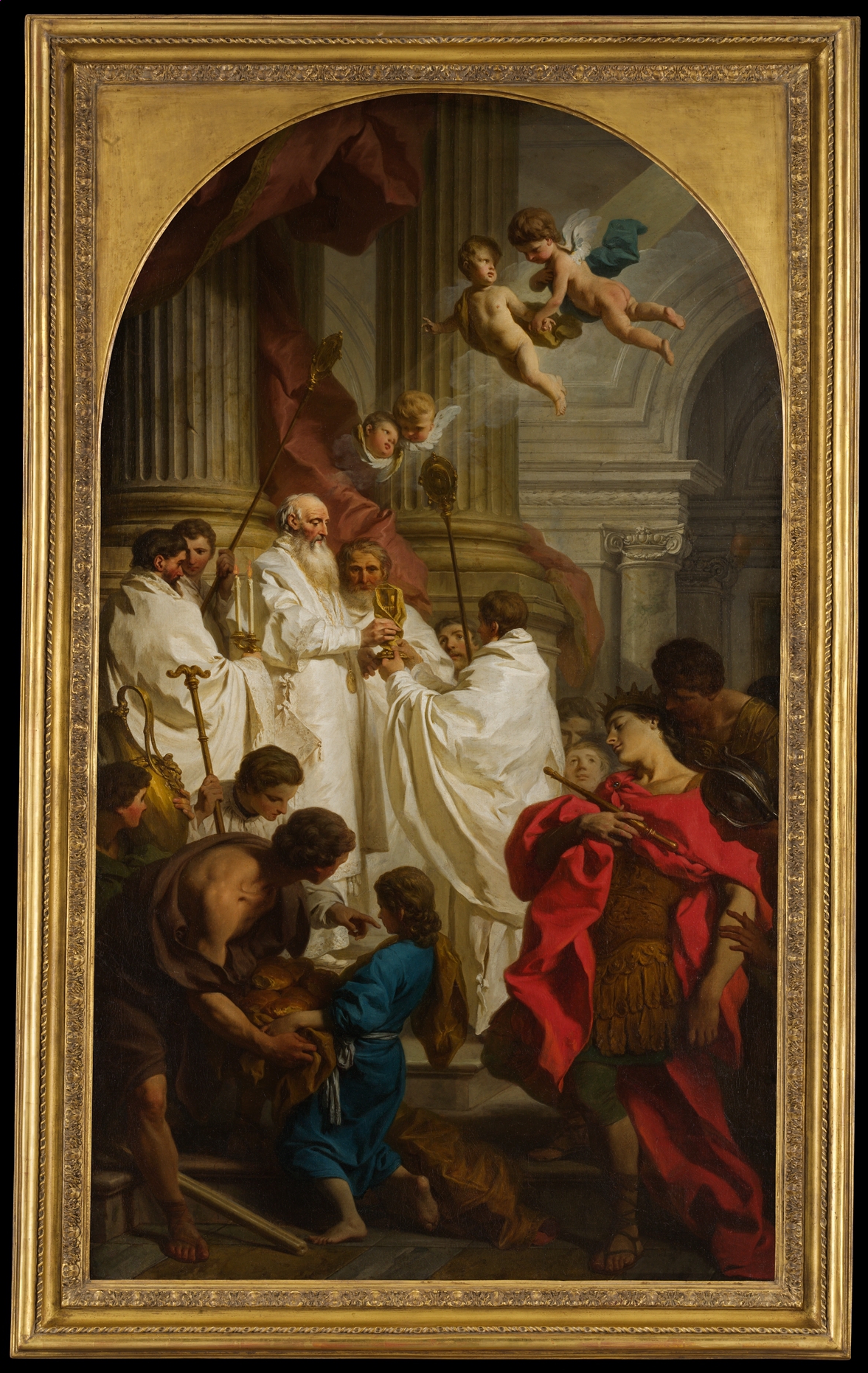
ABOUT THE ART
Pierre Hubert Subleyras, The Mass of Saint Basil, 1746, oil on canvas, transferred from canvas, 54 x 31 1/8 in., The Metropolitan Museum of Art, New York, Wrightsman Fund, 2007, accession number 2007.166.
This is Subleyras’s highly detailed sketch, or modello, for his most significant project: a design that would serve as the basis for a massive mosaic altarpiece at Saint Peter’s Basilica in Rome. In the painting, Saint Basil the Great (ca. 330–379) is shown celebrating Mass while the Emperor Valens (328–378) looks on. The artist’s exceptional ability to capture the full tonal range of white is evident in the robes of the priests surrounding Basil as he prepares to receive wine for Communion. The young emperor, distinguished by his bright red cape, dramatically faints in response to what he witnesses.
Saint Basil – June 14th
It is hard to overestimate the importance of St. Basil. He was what we would consider, today, a polymath. He was a gifted orthodox theologian, a social justice advocate, a leading bishop, and a poet/liturgist. There was very little he could not do.
Basil was born into a wealthy family, but found that spiritual growth required him to be free from his wealth. On visiting the monks in the Holy Land, he chose to give all of his wealth to the poor. He became a monk himself, but believed that the solitary life was not where one could grow the most spiritually. Instead, he founded a communal monastery with his friends, which became known as the Cappadocian Fathers and Mothers. They became famous for their learning and became the orthodox leaders against the Arian heresy, showing through their study that Jesus was of the very substance of God.
Despite the Emperor’s objection to their teaching, he was impressed and gave Basil a large property. The saint turned around and built a massive compound for those in need, including a poorhouse, hospice, and hospital. His friends likened what became known as the Basiliad to one of the great wonders of the world. Many of Basil’s words are remembered from his liturgies and theological works, but his words that have most haunted the church are:
“When someone steals another’s clothes, we call them a thief. Should we not give the same name to one who could clothe the naked and does not? The bread in your cupboard belongs to the hungry; the coat unused in your closet belongs to the one who needs it; the shoes rotting in your closet belong to the one who has no shoes; the money which you hoard up belongs to the poor.“
Basil was traditionally celebrated on January 1 in the season of Christmas. It is no wonder then that St. Basil, the great giver, instead of St. Nicholas, is the one who brings Christmas presents to Greek children. Eventually, his celebration was moved to June 14 to get it out of the Christmas season. However, in recent decades there has been a move to return his celebration to the Christmas Season.
Whenever you celebrate him, we recommend preparing Vasilopita, a Greek sweet bread. It is traditionally baked with a coin in the dough, bringing blessings to the one who receives it. It is a generous bread reminding us of this most loving and generous saint, who changed the world.

Vasilopita
Vasilopita is a traditional Greek cake or bread. A coin is often baked into the cake. The cake is a symbol of unity and is often shared with family and friends as a way to bring good luck and blessings.
Keep the screen of your device on
Ingredients
2 packages 2 active dry yeast or 4 1/2 teaspoons
2 cups 2 milk warmed
3/4 cup 3/4 plus 1 teaspoon sugar
7 to 7 1/2 cups 7 to 7 1/2 all-purpose flour
2 tablespoons 2 extra-virgin olive oil
1 teaspoon 1 salt
4 4 plus 1 eggs beaten
Zest of one large orange
Sesame seeds
Directions
- Dissolve the 2 packages active dry yeast in 1 cup of warmed milk with 1 teaspoon sugar. Allow to double in volume for 10-20 minutes.
- Meanwhile, stir together 7 cups of flour, 1 teaspoon salt, and the 3/4 cups sugar in a large mixing bowl. Make a well in the center. When the yeast has finished doubling, add to the well in flour mixture, as well as 2 tablespoons extra-virgin olive oil, 4 beaten eggs, the remaining 1 cup of milk, and the orange zest.
- Mix with a wooden spoon until dough is smooth.
- Turn dough out on a well floured surface and knead for about 10 minutes, adding more flour as needed if the dough is too sticky.
- Place in an oiled bowl, turning once to coat the top. Cover and allow to rise in a warm place for 1-2 hours, or until doubled in size.
- Punch dough down and divide into two portions. Knead each for a few minutes and place in two well-oiled 9-inch circular pans. Allow to rise until doubled in size for about one hour in a warm place.
- Using a pastry brush, brush the top of each loaf with the remaining beaten egg and sprinkle with sesame seeds.
- Bake at 375°F degrees F for 10 minutes, then turn the temperature down to 350°F and bake for another 30 minutes or until the tops of each loaf turn a deep chestnut brown.
- Allow to cool for at least 10 minutes before removing from the pan. Allow to cool completely on a cooling rack after removing it. At this point, you can insert a clean coin into the bottom of the loaf using a toothpick or skinny knife to push it in.